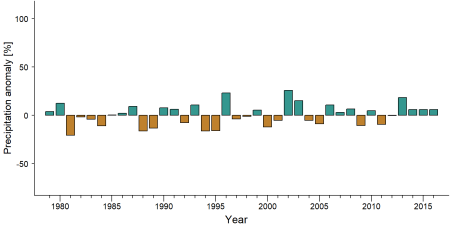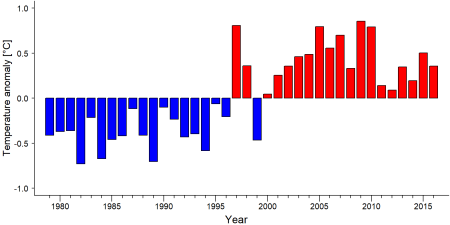Difference between revisions of "Bangassou Forest"
| Line 61: | Line 61: | ||
|''Pan troglodytes schweinfurthii'' | |''Pan troglodytes schweinfurthii'' | ||
|2003-2004 | |2003-2004 | ||
| − | | | + | |0 |
| − | | | + | |0 |
| − | | | + | |0 |
|Bangassou Forest | |Bangassou Forest | ||
|Index survey (reconnaissance walk) | |Index survey (reconnaissance walk) | ||
Revision as of 03:24, 12 March 2024
Central Africa > Central African Republic > Bangassou Forest
Summary
- Eastern chimpanzees (Pan troglodytes schweinfurthii) are likely absent in Bangassou Forest.
- The chimpanzee population is likely extinct.
- The chimpanzee population trend is unknown.
- The site has a total size of 12,000 km².
- Hunting has been a primary threat.
- Conservation activities are not documented.
Site characteristics
Bangassou is located in southeastern Central African Republic. The site is characterized by a blend of dense forest and savannah landscapes (Williamson & Maisels 2003, Williamson et al. 2004).
Table 1. Basic site information for Bangassou Forest
| Area | 12000 km² |
| Coordinates | 4.902833, 23.058449 |
| Designation | Non-protected area |
| Habitat types | Subtropical/tropical dry forest, savanna |
IUCN habitat categories Site designations
Ape status
During December 2003 and January 2004, a swift assessment of large mammal and human activity was conducted in Bangassou. This preliminary investigation served as a preparatory step for an inventory of Bangassou, which had been chosen as a site for the CITES MIKE (Monitoring of Illegal Killing of Elephants) program. Although the site has been considered to be at the limit of the chimpanzee range, no evidence of chimpanzees was found during the pilot study (Williamson & Maisels 2003, Williamson et al. 2004).
Table 2. Ape population estimates in Bangassou Forest
| Species | Year | Abundance estimate (95% CI) | Density estimate [ind./ km²] (95% CI) | Encounter rate (nests/km) | Area | Method | Source | Comments | A.P.E.S. database ID |
|---|---|---|---|---|---|---|---|---|---|
| Pan troglodytes schweinfurthii | 2003-2004 | 0 | 0 | 0 | Bangassou Forest | Index survey (reconnaissance walk) | Williamson et al. 2004 |
Threats
Table 3. Threats to apes in Bangassou Forest
| Category | Specific threats | Threat level | Quantified severity | Description | Year of threat |
|---|---|---|---|---|---|
| 1. Residential & commercial development | Unknown | ||||
| 2. Agriculture & aquaculture | Unknown | ||||
| 3. Energy production & mining | Unknown | ||||
| 4. Transportation & service corridors | Unknown | ||||
| 5. Biological resource use | 5.1 Hunting & collecting terrestrial animals | High | The Bangassou forest has been heavily hunted and in risk of becoming an 'empty forest' (Varty 2005). | Ongoing (2005) | |
| 6. Human intrusion & disturbance | Unknown | ||||
| 7. Natural system modifications | Unknown | ||||
| 8. Invasive & other problematic species, genes, diseases | Unknown | ||||
| 9. Pollution | Unknown | ||||
| 10. Geological Events | Absent | ||||
| 11. Climate change & severe weather | Unknown | ||||
| 12. Other options | Absent |
Conservation activities
Table 4. Conservation activities in Bangassou Forest
| Category | Specific activity | Description | Year of activity |
|---|---|---|---|
| 1. Residential & commercial development | Not reported | ||
| 2. Agriculture & aquaculture | Not reported | ||
| 3. Energy production & mining | Not reported | ||
| 4. Transportation & service corridors | Not reported | ||
| 5. Biological resource use | Not reported | ||
| 6. Human intrusion & disturbance | Not reported | ||
| 7. Natural system modifications | Not reported | ||
| 8. Invasive & other problematic species, genes, diseases | Not reported | ||
| 9. Pollution | Not reported | ||
| 10. Education & Awareness | Not reported | ||
| 11. Habitat Protection | Not reported | ||
| 12. Species Management | Not reported | ||
| 13. Livelihood; Economic & Other Incentives | Not reported |
Conservation activities list (Junker et al. 2017)
Challenges
Table 5. Challenges reported for Bangassou Forest
| Challenge | Source |
|---|---|
| Not reported |
Research activities
Documented behaviours
Table 6. Ape behaviors reported for Bangassou Forest
| Behavior | Source |
|---|---|
| Not reported |
Exposure to climate change impacts
As part of a study on the exposure of African great ape sites to climate change impacts, Kiribou et al. (2024) extracted climate data and data on projected extreme climate impact events for the site. Climatological characteristics were derived from observation-based climate data provided by the Inter-Sectoral Impact Model Intercomparison Project (ISIMIP, www.isimip.org). Parameters were calculated as the average across each 30-year period. For 1981-2010, the EWEMBI dataset from ISIMIP2a was used. For the two future periods (2021-2050 and 2071-2099) ISIMIP2b climate data based on four CMIP5 global climate models were used. For future projections, two Representative Concentration Pathways (RCP) were used. RCP 2.6 is a scenario with strong mitigation measures in which global temperatures would likely rise below 2°C. RCP 6.0 is a scenario with medium emissions in which global temperatures would likely rise up to 3°C by 2100. For the number of days with heavy precipitation events, the 98th percentile of all precipitation days (>1mm/d) was calculated for the 1979-2013 reference period as a threshold for a heavy precipitation event. Then, for each year, the number of days above that threshold was derived. The figures on temperature and precipitation anomaly show the deviation from the mean temperature and mean precipitation for the 1979-2013 reference period. The estimated exposure to future extreme climate impact events (crop failure, drought, river flood, wildfire, tropical cyclone, and heatwave) is based on a published dataset by Lange et al. 2020 derived from ISIMIP2b data. The same global climate models and RCPs as described above were used. Within each 30-year period, the number of years with an extreme event and the average proportion of the site affected were calculated (Kiribou et al. 2024).
Table 7. Estimated past and projected climatological characteristics in Bangassou Forest
| 1981-2010 | 2021-2050, RCP 2.6 | 2021-2050, RCP 6.0 | 2071-2099, RCP 2.6 | 2071-2099, RCP 6.0 | |
| Mean temperature [°C] | 24.8 | 26 | 25.9 | 26.2 | 27.3 |
| Annual precipitation [mm] | 2425 | 2486 | 2516 | 2533 | 2596 |
| Max no. consecutive dry days (per year) | 35.9 | 35.8 | 35 | 37.4 | 38.6 |
| No. days with heavy precipitation (per year) | 6.2 | 9.2 | 10 | 10.4 | 11 |
Table 8. Projected exposure of apes to extreme climate impact events in Bangassou Forest
| No. of years with event (2021-2050, RCP 2.6) | % of site exposed (2021-2050, RCP 2.6) | No. of years with event (2021-2050, RCP 6.0) | % of site exposed (2021-2050, RCP 6.0) | No. of years with event (2070-2099, RCP 2.6) | % of site exposed (2070-2099, RCP 2.6) | No. of years with event (2070-2099, RCP 6.0) | % of site exposed (2070-2099, RCP 6.0) | |
| Crop failure | 15 | 0.44 | 9.5 | 0.58 | 17 | 0.34 | 24.5 | 0.67 |
| Drought | 0 | 0 | 0 | 0 | 0 | 0 | 0 | 0 |
| Heatwave | 3 | 62.5 | 4 | 70 | 4.5 | 68.06 | 7.5 | 80.49 |
| River flood | 1 | 0.16 | 1 | 0.69 | 1.5 | 0.56 | 2.5 | 1.49 |
| Tropical cyclone | 0 | 0 | 0 | 0 | 0 | 0 | 0 | 0 |
| Wildfire | 30 | 0.65 | 30 | 0.65 | 29 | 0.64 | 29 | 0.66 |
References
Kiribou, R., Tehoda, P., Chukwu, O., Bempah, G., Kühl, H. S., Ferreira, J., ... & Heinicke, S. (2024). Exposure of African ape sites to climate change impacts. PLOS Climate, 3(2), e0000345.
Varty, N. (2005). Central African Republic. World Atlas of Great Apes and Their Conservation. UNEP World Conservation Monitoring Center, 314.
Williamson, L., & Maisels, F. (2003). Bangassou Forest, Central African Republic Conservation Status, Large Mammals and Human Impact. Unpublished report to WCS/MIKE.
Williamson, L., Bayogo, R., Guimiyessi, G., Ouangbao, P., Saboundou, A., Blake, S., & Maisels, F. (2004). Survey of elephants Bangassou, Central African Republic: conservation status & human impacts. Unpublished report to WCS/MIKE.
Page completed by: A.P.E.S. Wiki team Date: 11/03/2024

